Zircon U-Pb dating, geochemical, and Sr-Nd-Pb-Hf isotopicconstraints on the age and origin of intermediate to felsic igneous rocks at South Altyn, Xinjiang, China
2020-11-10ShenLiuCaixiaFengYanFanXiaoqingChenYuhongYangHuiboZhaoIanCoulson
Shen Liu · Caixia Feng · Yan Fan · Xiaoqing Chen · Yuhong Yang ·Huibo Zhao · Ian M. Coulson
Abstract As a part of a giant trending fault system in the Asian continent and one where a strong zone of left strikeslip fault is present, the Altyn Orogenic belt (AOB) has become an important focus for research. Magmatic rocks are widely distributed across the AOB. However, many investigations have focused primarily on Paleozoic igneous rocks; discussion of Mesozoic related igneous activity is often ignored. Here we present the result of studies of representative diorite and granite rocks outcropping in the AOB, within the Xinjiang Uygur Autonomous Region,South Altyn, China. We present new zircon LA-ICP-MS U-Pb age, geochemical, and Sr-Nd-Pb-Hf isotopic data for these sample suites,identifying them as typical igneous rocks formed between 238 ± 1.5 and 238.8 ± 1.1 Ma.The rocks that we studied fall into the alkaline series, also enriched in light rare earth elements (LREE), some large ion lithophile elements(LILE;e.g.,Rb,Ba,Sr,and K),Pb,Th and U, and depleted in heavy rare earth elements(HREE), Nb, Ta, Hf, and Ti. The granite and diorite have high initial 87Sr/86Sr ratios (0.7062-0.7114), negative εNd(t) values (- 8.8 to - 11.3), εHf (t) values (- 8.7 to- 18.7), and relatively constant Pb isotopic ratios ((206-Pb/204Pb)i = 6.74-17.884, (207Pb/204Pb)i = 15.51-15.58,and (208Pb/204Pb)i = 35.36-38.04), respectively. This suggests that the magmas parental to these rocks were generated from the partial melting of the ancient crust.The parental magmas to these rocks experienced a degree of fractionation of plagioclase, K-feldspar, and hornblende,possibly during rapid magma ascent. Based on these studies,we propose a reasonable model for the origin of the investigated rocks from the Xinjiang Uygur Autonomous Region of South Altyn, which involves crustal thickening,lithospheric extension, and asthenosphere upwelling, that induced crustal melting.
Keywords Altyn orogenic belt · Zircon U-Pb dating ·Geochemistry, Sr-Nd-Pb-Hf isotope · Origin
1 Introduction
The Altyn orogenic belt (hereafter AOB) is located at the southwest margin of the Central Asian orogenic belt.It is a complex orogenic belt composed of a series of continental blocks, island arcs, and accretionary units, that extends for~1000 km across China, Russia, Kazakhstan and Mongolia (Li et al. 2020). Moreover, this composite orogenic belt comprises geological units of different geological periods, a variety of structural levels and that formed in distinct tectonic environments. The dominant structures within the AOB are those located in the northern margin of the Qinghai-Tibet Plateau, the southeast margin of the Tarim Basin, the western margin of the Qaidam Basin and the Qilian Kunlun orogenic belt(Luo et al.2009),whereas the southern part of the belt is limited by the giant Altyn sinistral fault (Wu et al. 2016). From north to south, the AOB can be subdivided into five tectonic units: the North Altyn Block, the North Altyn ophiolitic melange belt, the middle Altyn massif, the South Altyn high pressure and ultra-high- pressure (HP-UHP) metamorphic belt, and the Apa-Mangya ophiolite tectonic melange belt(Che and Sun 1996;Wang 1997;Xu et al.1999;Cui et al.2002;Liu et al.2009a, b, 2015; Yang et al. 2012; Wang et al. 2011; Kang et al. 2013; Chen 2018).
The AOB experienced Archean to Paleoproterozoic continental core and crystalline basement formation (Lu and Yuan 2003), plate convergence and collision in the early Neoproterozoic (Qin et al. 2006), plate expansion in the late Neoproterozoic to Early Paleozoic(Liu et al.1998,1999), followed by Caledonian plate subduction and collision(Liu et al.2015;Kang et al.2016a,b;Wu et al.2018)and lastly, late Yanshanian large-scale, sinistral faulting(Guo et al. 2008; Wu et al. 2013). As an important part of the northern margin of the Qinghai-Tibet Plateau,the main fault of the southern Altyn Tagh (hereafter South Altyn)forms a principal zone of sinistral faulting in Central Asia.As such, a comprehensive understanding of the formation and evolution history of the South Altyn is of great scientific significance to the division of geological structures in both Northwest China and the Central Asian continent(Wang et al.2019).For example,this complex tectonic belt owes its formation to the subduction and collision of paleoplates(or blocks)in the Early Paleozoic and experienced a convoluted tectonic evolution process in the Mesozoic(Chen et al.1995,1998;Liu et al.1996;Zhang et al.1999a,b, 2001a, b, c; Xu et al. 1999; Cui et al. 1999; Ni et al.2008;Kang et al.2013;Li et al.2015).The Early Mesozoic(Triassic) outcrops in this area experience uplift and denudation, while the Middle and Late Mesozoic (Jurassic to Cretaceous) resulted in rifting and a stage of sedimentation(Huang et al.2004).In recent years,the South Altyn area has become a hot spot for geologists (Zhao et al.2018). However, the related research has mainly focused on the high-pressure and ultra-high-pressure metamorphism (Liu et al. 1997, 1998, 2002, 2003,2004, 2005, 2007a, b, c, 2009a, b, c, 2012; Zhang et al.1999a, 2001a, b, 2002a, b, 2004, 2005; Zhang and Meng 2005; Cao et al. 2009; Wang et al. 2011), ophiolites (Li et al. 2009; Ma et al. 2009), and intermediate felsic intrusive rock(Zhang et al.1999a, b,2001a,b,2002a, b,2007;Cao et al. 2010; Tian 2009; Sun et al. 2012; Yang et al.2012;Kang et al.2013,2016a,b;Wu et al.2014,2016;Liu et al. 2015; Pan et al. 2016; Wang et al. 2019; Li et al.2020). These studies have provided systematic scientific evidence for the tectonic evolution of the south margin of Altyn Tagh during the Nanhua Early Paleozoic Ocean and transition. Nevertheless, research relating to magmatism and igneous rocks are limited primarily to the Paleozoic period (262-504 Ma); discussion of Mesozoic igneous activity has largely been ignored. Because of this, our paper aims to study and discuss the nature and significance of Mesozoic granite and diorite at Qiemo County,southern margin of the Altyn sinistral Fault Zone. These investigations include zircon U-Pb dating, whole-rock major and trace element compositions, coupled to Sr-Nd-Pb isotope and zircon Hf isotope studies.Based on the above research,a credible genetic age and origin are reasonably determined.
2 Regional geological background and sample petrological characteristics
The protracted evolution of the AOB includes this having experienced ancient Archean crust formation and multistage magmatic activities, strong transformation, and intermediate-mafic magmatism during the Paleoproterozoic(2.5-1.8 Ga), Neoproterozoic(1.0-0.8 Ga) collisional orogeny and large-scale magmatism (Wang et al.2006, 2011; Liu et al. 2009a, b, c), as well as, complex,structural belt formation by subduction and collision of ancient plates (or blocks) in the Early Paleozoic, that were later transformed by a Mesozoic-Cenozoic sinistral fault system. The South Altyn is located between the southern Altyn sinistral Fault and the southern margin fault of Altyn(Liu et al.1998;Wang et al.1999),it differs from the Sulu-Dabie ultra-high pressure metamorphic belt which represents an area of deep subduction collision within the Yangtze Craton (Suo et al. 2004).
The present study area is located in the complex rock of the Ananmanya tectonic belt (Fig. 1), mainly comprising old metamorphic rocks (500-1000 Ma; granite and granite gneiss; Liu et al. 2007a, 2015; Lu et al. 2008; Wang et al.2008;Song et al.2012;Fan et al.2019),such as the Paleo-Proterozoic Altyn Group, middle Proterozoic Bashkorgan Group, and the Neoproterozoic Solcuri Group, as well as,Mesozoic-Jurassic, Cenozoic-Paleogene, Neogene and Quaternary systems. Mafic-ultramafic rocks and intermediate-felsic rocks of the Jinning, Caledonian, Hercynian,and Yanshanian periods are very well developed in the study area, and they are distributed in a beaded pattern along the southern edge of the South Altyn, forming relatively large rock units. In addition, intermediate-felsic rocks are mainly distributed in the southern part of the main fault zone.
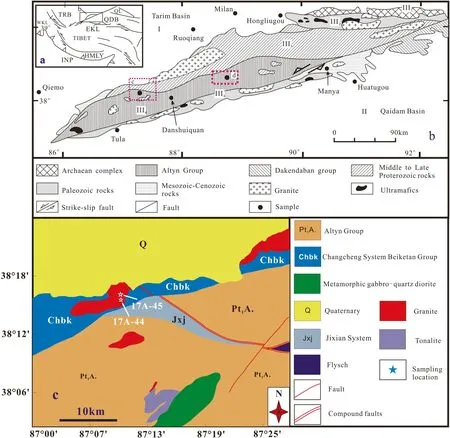
Fig. 1 a Tectonic divisions of west China (Liu et al. 2012), b geological and tectonic map of the Altyn Tagh Orogen (Liu et al. 2012), and c geological map of the southeastern Altyn
Samples for this study were collected at outcrop from Chimo County, South Altyn in the Xinjiang Uygur Autonomous Region, China (Fig. 1). The diorite (sample 17A-44-1-10) has a semi-autochthonous medium-finegrained equigranular structure. Its mineral composition includes plagioclase, K-feldspar, hornblende, biotite, and minor quartz (<5 %) (Fig. 2). Locally, diorite is commonly observed interlayered with marble (~4.0 m). The sample 17A-44-1 is selected for zircon separation. In contrast, the granite (e.g., porphyritic granite, K-feldspar granite,and gneissose granite)(sample 17A-45-1-12)has a coarse-grained equigranular structure, and its mineral composition includes semi-autochthonous quartz(45-50 %, 0.2-1.0 cm), autochthonous- semi-autochthonous K-feldspar (35-40 %) and plagioclase(5-10 %)(Fig. 2).Some outcrops of the porphyritic granite have obvious mylonitization and are cut by mafic intrusions (dykes), whereas the gneissose granites have xenoliths within of dark gabbro. Both the dark inclusions and granites have suffered deformation, and each contains tourmaline.And the sample 17A-45-3 is selected for zircon separation.
3 Analytical procedures
3.1 U-Pb dating by laser-ablation-inductively coupled plasma-mass spectrometry (LA-ICPMS) methods
Zircon from five of the investigated Xinjiang Uygur Autonomous Region samples was separated using conventional heavy liquid and magnetic techniques. Representative zircon grains were then hand-picked under a binocular microscope before being mounted in an epoxy resin disc, polished, and then coated with gold, before the analysis. Individual crystals were studied using optical microscopy techniques and under cathodoluminescence(CL) to aid in characterization and to reveal any internal features. CL imaging (Fig. 2) and the U-Pb analyses were undertaken by LA-ICP-MS methods at the State Key Laboratory of Continental Dynamics, Xi’an, China. The analytical procedures used were those as described in detail in Harris et al.(2004);a spot diameter of 29 μm was used.U-Th-Pb ratios and absolute abundances were determined by reference to replicate measurements of a standard TEMORA zircon and the NIST 610 glass standard(Figs. 3,4).
3.2 Major elemental and trace elemental analyses

Fig. 2 Representative cathodoluminescence (CL) images for zircon in the rocks from the Xinjiang Uygur Autonomous Region of South Altyn
Whole-rock major element compositions were determined using analytical Axioms-advanced X-ray fluorescence(XRF) spectrometer at the State Key Laboratory of Ore Deposit Geochemistry (SKLODG), Guiyang, China with an analytical precision of better than 5 %. Trace element compositions were determined by Inductively-coupled plasma mass-spectrometry (ICP-MS) utilizing a Perkin-Elmer ELAN DRC-e instrument at the SKLODG. Prior to analysis, powdered samples (50 mg) were dissolved in high-pressure Teflon bombs, using an HF + HNO3acid attack for 48 h, at a temperature of ~ 190 °C (Qi et al.2000). Signal drift was monitored during the analysis by reference to an Rh internal standard.GBPG-1,OU-6,GSR-1, and GSR-3 standards were additionally used for analytical quality control with a determined analytical precision of better than 5 %.

Fig. 3 The corresponding LA-ICP-MS U-Pb concordia diagrams for the rocks studied from the Xinjiang Uygur Autonomous Region of South Altyn

Fig. 4 Representative photomicrographs of the studied granitic rock from the Xinjiang Uygur Autonomous Region of South Altyn. Key: Q:quartz, Pl: plagioclase, Bi: biotite, Hb: hornblende, Kfs: K-feldspar
3.3 Sr-Nd-Pb isotopic analyses
For Rb-Sr and Sm-Nd isotope analyses, sample powders were spiked with mixed isotope tracers, following dissolution with HF + HNO3acids (in Teflon bombs). The isotopes were separated by conventional cation-exchange techniques.Isotopic measurements were performed using a Finnigan Triton Ti thermal ionization mass spectrometer(TIMS) at the SKLODG. Procedural blanks yielded concentrations of < 200 pg for Sm and Nd, and < 500 pg for Rb and Sr,respectively.The mass fractionation corrections for Sr and Nd isotopic ratios were based on86Sr/88Sr = 0.1194 and146Nd/144Nd = 0.7219. Analysis of the NBS987 and La Jolla standards yielded the following results:87Sr/86Sr = 0.710246 ± 16 (2σ), and143Nd/144Nd = 0.511863 ± 8 (2σ), respectively. Prior to Pb isotopic analysis, Pb was separated and purified by conventional cation-exchange techniques, using diluted HBr as an eluent.Analysis of the NBS981 standard yielded mean values for204Pb/206Pb of 0.0896 ± 15,207Pb/206Pb of 0.9145 ± 8, and208Pb/206Pb of 2.162 ± 2.
3.4 In-situ zircon Hf isotopic analysis
In-situ zircon Hf isotopic analyses were conducted using a Neptune multi-collector system (MC-ICP-MS), equipped with a 193 nm laser, at the Institute of Geology and Geophysics, Chinese Academy of Sciences in Beijing, China.During the analysis, a laser repetition rate of 10 Hz at 100 mJ was used with spot sizes of 32 and 63 μm. Raw count rates for172Yb,173Yb,175Lu,176(Hf + Yb + Lu),177Hf,178Hf,179Hf,180Hf, and182W were collected and isobaric interference corrections for176Lu and176Yb on176Hf were determined precisely.176Lu was calibrated using the175Lu value and a correction was made to176Hf. The176Yb/172Yb value of 0.5887 and mean βYbvalue obtained during Hf analysis on the same spot were applied for the interference correction of176Yb on176Hf (Iizuka and Hirata 2005). Details of the analytical techniques employed are described in Xu et al. (2004) and Wu et al. (2006).During the analysis, the determined176Hf/177Hf and176Lu/177Hf ratios of the standard zircon (91500) were 0.282300 ± 15 (2σn, n = 24) and 0.00030, respectively,which are similar to the commonly accepted176Hf/177Hf ratio of 0.282302 ± 8 and 0.282306 ± 8 (2σ) measured using the solution method (Goolaerts et al. 2004; Woodhead et al. 2004).
4 Results
4.1 Zircon U-Pb dating
Clean,prismatic grains of euhedral zircon in samples 17A-44 and 17A-45 series display evident oscillatory zoning,suggesting that these were the products of a crystallizing magma. A total of 17 zircon grains provided a weighted mean206Pb/238U age of 238.8 ± 1.1 Ma (1σ) (95 % confidence interval, MSWD = 3.6) for 17A-44 (Table 1),whereas 17 zircon grains from sample 17A-45 gave a weighted mean206Pb/238U age of 238.0 ± 1.5 Ma (1σ)(95 %confidence interval,MSWD = 5.2)(Table 1).These determinations are the best estimates for the crystallization ages of the investigated intermediate and felsic intrusive rocks from the Xinjiang Uygur Autonomous Region. No inherited zircon characteristics were observed in the investigated sample populations.
4.2 Major and trace elements
Whole-rock geochemical data for the studied rocks are presented in Tables 2 and 3. The diorite samples exhibit a fairly narrow range of compositions (Table 2); each is situated within the alkaline field in terms of the total alkalisilica diagram (Fig. 5). By contrast, the granite samples exhibit a relatively wide range of compositions (Table 2).While all of the granite samples also fall into the alkaline field in terms of the total alkali-silica diagram (Fig. 5a),they additionally reside within the shoshonitic series field in terms of a plot of Na2O versus K2O (Fig. 5b) and are metaluminous (A/CNK = 0.7-1.0; Fig. 5c) in terms of aluminum saturation (Maniar and Piccoli 1989; Ji et al.2016). Moreover, all samples studied are characterized by light rare earth element(LREE)enrichment and heavy rare earth element (HREE) depletion, with a narrow range of Eu/Eu* (0.73-1.05) and high (La/Yb)Nratios (61-169)(Table 3 and Fig. 6a, b). On primitive mantle-normalized trace element diagrams,the studied rocks show enrichment in LILEs(i.e.,Rb,Ba,Sr,K),Th,U and Pb,and depletion for HFSEs (i.e., Nb, Ta, Hf, and Ti) (Fig. 6b).
4.3 Sr-Nd-Pb isotopes
Sr, Nd, and Pb isotopic data for 14 representative rocks from this study are presented in Tables 4,5 and Figs. 7,8a,b. The diorite samples exhibit a wide range in (87Sr/86Sr)ivalues of between 0.7062 to 0.7090 and wide variation in εNd(t) values, from - 9.1 to - 11.3. The granite samples similarly exhibit a wide range in (87Sr/86Sr)ivalues of between 0.705 to 0.7114 and wide variation in εNd(t) values, from - 8.8 to - 10.5. These data are suggestive of source areas with slight enrichment. The investigated diorite rocks display relatively constant Pb isotopic ratios of: (206Pb/204Pb)i= 16.61-17.88, (207Pb/204Pb)i-= 15.56-15.58 and (208Pb/204Pb)i= 37.47-38.04. The investigated granite units also display relatively constant Pb isotopic ratios of: (206Pb/204Pb)i= 17.03-17.76, (207-Pb/204Pb)i= 15.45-15.55 and(208Pb/204Pb)i= 37.10-37.69.
4.4 Zircon Hf isotope analysis
The results for zircon Hf isotope analyses in the studied samples are listed in Table 6. Twenty-five spot analyses were obtained for sample 17A-44, yielding very uniform εHf(t) values of between -8.7 and -11.2, which correspond to TDM2model ages of between 1814 and 1976 Ma(Figs. 9, 10). Twenty-five spot analyses were obtained for sample 17A-45; they show a lower range of εHf(t) values of between -14.5 and -18.7, corresponding to TDM2model ages of between 2182 and 2440 Ma (Figs. 9, 10).
5 Discussion
As one of the most widely distributed rock types and an important sign of continental crustal growth, intermediatefelsic igneous rock, especially granite, is an excellent window and research object in studies of the growth and tectonism of continental crust (Xiao et al. 2005). For example, based upon the study of granites in the Lachlan fold belt of Australia, the classification of the S-type,I-type, A-type, and M-type granites were proposed(Chappell and White 1974; White and Chappell 1983).A-type is used to describe felsic rocks,which in addition to appearing in anorogenic tectonic settings, are more alkaline. A-type granites appear to be polygenetic, with no single process accounting for them all. Such magmas can form through melting of the lower crust under conditions that are usually extremely dry, or in the fractionation of basaltic magma. M-type covers those granites that derive from mafic or intermediate magmas, generally sourced from the mantle. These are rare, usually occurring only in oceanic crust within an ophiolite suite, and mostly associated with basalt and meta aluminous plagioclase granite.In general, the aluminous saturation index (A/CNK; Maniar and Piccoli 1989) is used to delineate the boundary between I-type (igneous protolith) granite and S-type(sedimentary protolith) granite. Rocks with an A/CNK of>1.1 are strongly peraluminous, and typically belong to the S-type granite; a value for A/CNK of <1.1 is weakly aluminous and representative of I-type granite.

Table 2 Major oxides (wt %) of the studied rocks from Xinjiang Uygur Autonomous Region of South Altyn
5.1 The source of the Xinjiang Uygur Autonomous Region magmas
The rocks investigated from Xinjiang Uygur Autonomous Region are characterized by the following isotopic compositions: high (87Sr/86Sr)i= (0.7062-0.7114), (206Pb/204-Pb)i= (16.74-17.88), (207Pb/204Pb)i= (15.51-15.58), and(208Pb/204Pb)i= (35.36-38.04), negative εNd(t) and εHf(t) values of (- 8.8 to - 11.3, and -8.7 to -11.2), and high (La/Yb)Nratios of 61-169 (see Table 3, 4, 5, 6;Figs. 6a,b,7,8a,b,9,10),implying that they were derived from a relatively enriched magma source area. In addition,the diorite and granite samples have negative εHf(t)(- 8.7 to- 11.2,and - 14.5 to - 18.7)relating to an older twostage model age(1.8-2.0 Ga,2.2-2.4 Ga),which indicates that the rocks likely derived from an ancient crustal source(Taylor and McClennan 1985; Wu et al. 2007). This is further supported by their higher SiO2contents(50.27-72.96, Table 2). Although the rocks studied have similar REE, trace element and isotopic characteristics,there are also some important differences. Such characteristics indicate that the granite and diorite investigated from Xinjiang Uygur Autonomous Region may have two different sources or origins.
To decipher if and how mantle materials may have participated in the genetic process of these rocks requires some explanation. In general, there are two ways for mantle material to influence a source area: 1. The mantlederived components can provide heat input to induce partial melting of crustal materials and thereby produce a spectrum of magma compositions, depending upon the heterogeneity of source materials. As such, felsic magma may directly be linked at its source to the formation of diorite (Griffin et al. 2002; Kemp et al. 2007; Zhao et al.2010, 2012). 2. The lower crust was formed through the underplating of mantle-derived components, and then partially melted to form diorite under the influence of later thermal events (Jahn et al. 2000; Wu et al. 2006; Zheng et al. 2007). Generally, the two-stage model ages of igneous rocks are quite different from their metamorphicages; the possibility of the second mode of genesis thus is plausibly ruled out in this study.

Table 3 The trace elements analysis results (ppm) for the studied rocks from Xinjiang Uygur Autonomous Region of South Altyn
5.2 Fractional crystallization

◀Fig. 5 Classification of the granitic rocks from the Xinjiang Uygur Autonomous Region on the basis of: a the total-alkali versus SiO2(TAS)diagram.All the major element data have been recalculated to 100 % on a LOI-free basis (Middlemost 1994; Le Maitre 2002);b K2O versus Na2O diagram, showing the alkaline association to be shoshonitic (Middlemost 1972); and (c) Al2O3/(Na2O + K2O) molar versus Al2O3/(CaO + Na2O + K2O) molar plot (Maniar and Piccoli 1989)
On Harker plots (Fig. 11), with increasing SiO2content,MgO, TiO2, and Fe2O3decrease, which shows a typical magmatic mixing or fractional crystallization (e.g.,K-feldspar and hornblende) evolutionary trend. Moreover,Na2O does not change greatly with an increase of SiO2,but Al2O3and CaO decrease as SiO2increases. The negative anomalies observed for Eu and Sr in the investigated rocks(Table 3, Fig. 6a, b) indicate that plagioclase crystallization was important during magma evolution.However,the fractional crystallization of plagioclase in granite is relatively weaker than for diorite, reflecting its lower Sr contents (Table 3, Fig. 6a, b).

Fig. 6 a Chondrite-normalized REE diagrams: b primitive mantlenormalized trace element distribution spiderdiagrams. The normalization values are from Sun and McDonough (1989)

2σ (87Sr/86Sr)i 0.70 7245 0.70 6178 0.70 7800 0.70 8982 0.70 7245 0.70 7244 0.70 8991 0.71 0689 0.71 0672 0.71 0508 0.71 1431 0.71 142245 0.71 141174 0.71 144034 09120928092809 87Sr/86Sr 0.70 8525 1 0.70 8994 0.70 9846 1 0.70 9999 1 0.70 8395 1 0.70 8438 0.70 9938 1 0.71 1525 0.71 1813 1 0.71 1831 0.71 2572 1 0.71 3108 0.71 3404 1 0.71 3502/8 6S r87Rb 680.37 900.82 230.60 940.29 870.33 150.35 880.27 690.24 720.33 080.39 720.33 790.49 850.58 900.60 m)r (pp 2816253) S 6730 6340 4620 4010 6432 3935 412853393369685341(pp mRb 83.4 78.1 23381.4 158167198194156175 d)i εNd (t)- 9.1- 1 0.2- 1 1.1 172- 9.4- 1 1.2- 1 1.3 242- 1 1.2 245- 1 0.5 158- 9.1- 9.0- 8.8- 9.1- 9.3- 9.24Nd/14 6509644857535895666980675459 3N 0.5118 0.5118 d 2σ (14 0.5117 0.5118 0.5117 0.5117 0.5117 0.5117 0.5118 0.5118 0.5118 0.5118 0.5118 0.5118 78866787766766 iorite rocks in this study d/144N2244979997866489858479655762 3N14 0.5120 0.5120 0.5119 0.5119 0.5119 0.5119 0.5119 0.5119 0.5120 0.5120 0.5120 0.5120 0.5120 0.5120 4N d ranite and d m/14 14 7S 0.1002 0.1507 0.1490 0.0965 0.1537 0.1491 0.1319 0.1245 0.1405 0.1384 0.1282 0.1274 0.1305 0.1303 sitions for the g d (ppm)920 65.8 3546 2466.2 4748 1433.2 12.52.19 85.7 85.4 33.1 13.3 po .9.1.8.7.3.2.3.8.6 isotopic com m (ppm) N Age (Ma) S 272051602161624.10 2.05 0.33 15154.13 2.06 8.823 23 8 Table 4 S r-Nd Samples 17A-44-1 17A-44-2 17A-44-3 17A-44-4 17A-44-6 17A-44-8 17A-44-10 17A-45-1 17A-45-2 17A-45-4 17A-45-5 17A-45-6 17A-45-9 17A-45-12
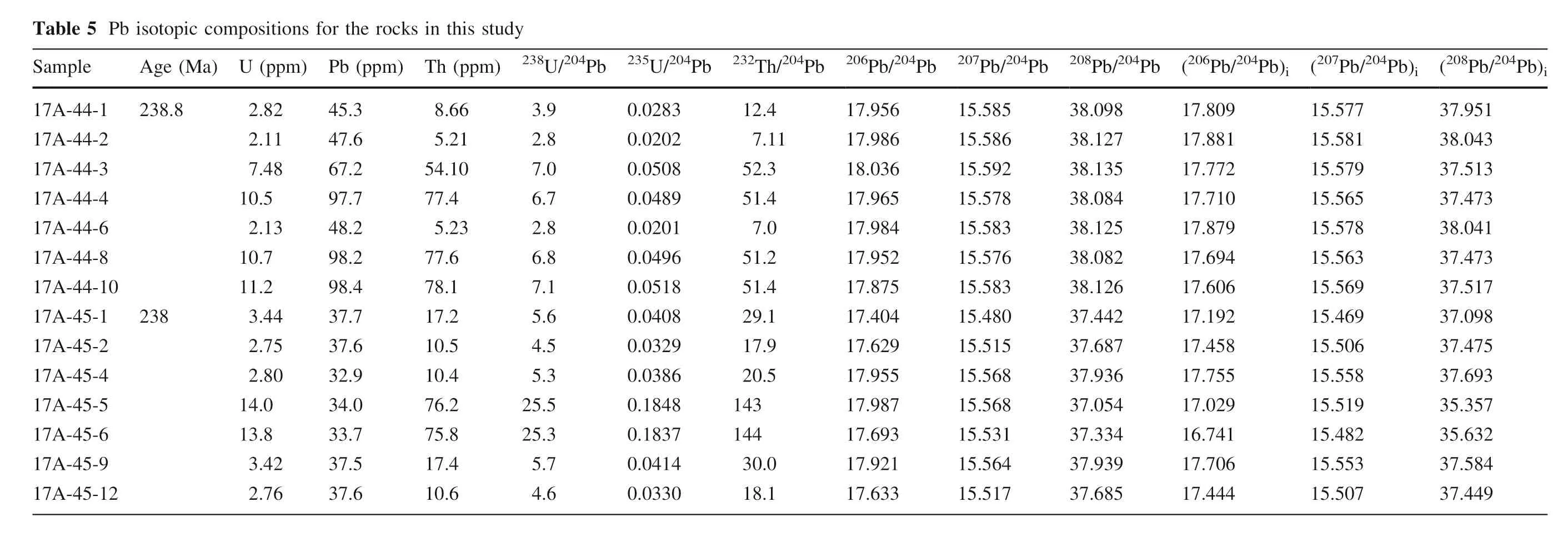
4P b)i 8P b/20 5143137341731798759357328449 b)i (2037.9 38.0 37.5 37.4 38.0 37.4 37.5 37.0 37.4 37.6 35.3 35.6 37.5 37.4 b/20 4P7Pb)i (20 15.577 15151515151515151515151515.581.579.565.578.563.569.469.506.558.519.482.553.507 4P 6P b/20 17.809 17.881 17.772 17.710 17.879 17.694 17.606 17.192 17.458 17.755 17.029 16.741 17.706 17.444 4P b(2 0b/208P20 38.098 38.127 38.135 38.084 38.125 38.082 38.126 37.442 37.687 37.936 37.054 37.334 37.939 37.685 4P bb/20207P 15.585 15.586 15.592 15.578 15.583 15.576 15.583 15.480 15.515 15.568 15.568 15.531 15.564 15.517 4P bb/20 6P 5686366584527504295587932133 2017.9 17.9 18.0 17.9 17.9 17.9 17.8 17.4 17.6 17.9 17.9 17.6 17.9 17.6 4P b 2T h/2 023 12.47.11 52.3 51.47.0 51.2 51.4 29.1 17.9 20.53 1414 430.0 18.1 4P b/205U23 0.0283 0.0202 0.0508 0.0489 0.0201 0.0496 0.0518 0.0408 0.0329 0.0386 0.1848 0.1837 0.0414 0.0330 4P b/208U sitions for the rocks in this study 233.92.87.06.72.86.87.15.64.55.3 25.5 25.35.74.6 h (pp m)b (ppm) T 8.66 5.21 54.10 77.45.23 77.6 78.1 17.2 10.5 10.4 76.2 75.8 17.4 10.6.34547.6 67.2 97.7 48.2 98.2 98.4 37.7 37.6 32.9 34.0 33.7 37.5 37.6 pm) P po (p 2.82 2.11 7.48 2.13 3.44 2.75 2.80 3.42 2.76 topic com 10.5 Age (Ma) U 10.7 11.2 14.0 13.8 23 8.8 23 8 ble 5 P b iso 0 2 Ta Sample 17A-44-1 17A-44-2 17A-44-3 17A-44-4 17A-44-6 17A-44-8 17A-44-1 17A-45-1 17A-45-2 17A-45-4 17A-45-5 17A-45-6 17A-45-9 17A-45-1
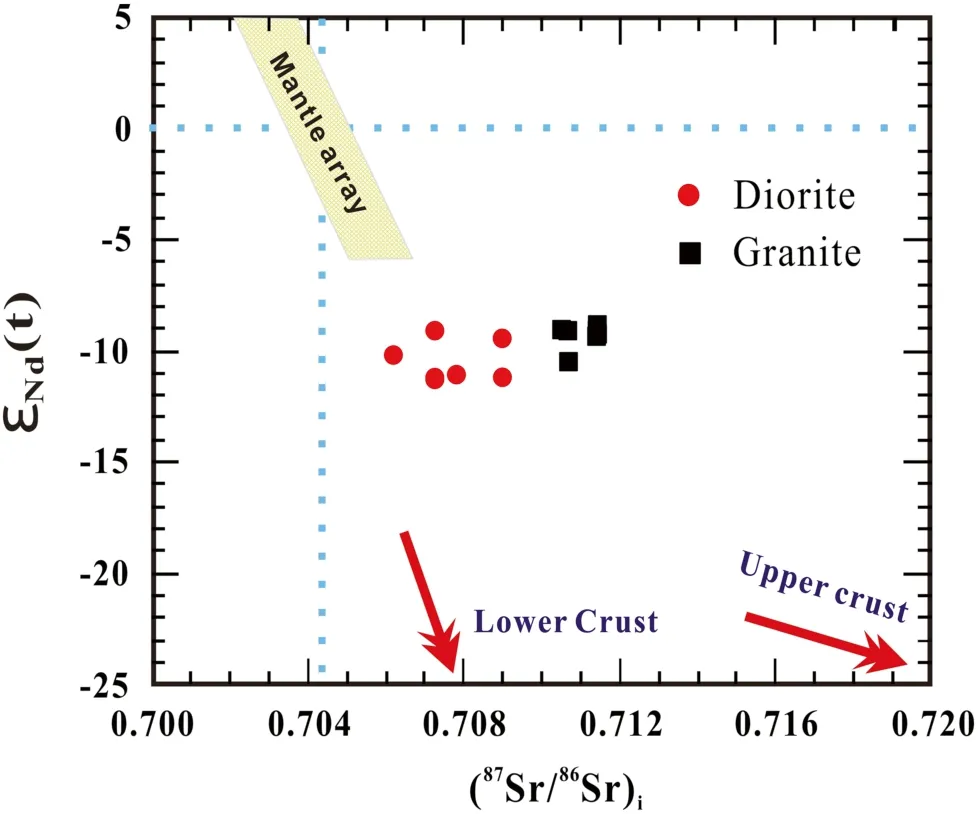
Fig. 7 Initial 87Sr/86Sr versus εNd (t) diagram for the rocks studied from the Xinjiang Uygur Autonomous Region of South Altyn, China
5.3 Origins
There are clear negative correlations between MgO, TiO2,Fe2O3and SiO2contents (Fig. 11a-c) for the Xinjiang Uygur Autonomous Region diorite and granite samples as studied,indicating that the separation and crystallization of mafic minerals (mainly amphibole and to a lesser extent biotite) accompanied their evolution (Wang 2010; Wang et al. 2010). This observation is further supported by Th enrichment and Nb-Ta depletion in the investigated intermediate-felsic igneous rocks(Fig. 6b;Wu et al.2001).In addition, these rocks are characterized by high Rb, Ba,Th,U,K,and LREE contents(Table 2;Fig. 6a,b),high to very high Zr/Hf ratios(133-3477),low Mg#values(29-46,Table 2), and depletion in Nb, Ta, Ti, and HREE (Fig. 6).Generally, the experimental petrology theory shows that the CaO/Na2O ratio can be used to distinguish the characteristics of intermediate to felsic magmatic rocks (Kang et al. 2016a, b). The CaO/Na2O ratio for the investigated diorite samples falls between 0.95 and 1.31,indicating that the original rock (as melted) should be clastic rock with a small proportion of mudstone. By contrast, except for samples,17A-45-6 and 17A-45-8,the relatively high CaO/Na2O(0.55,0.54),the high CaO/Na2O ratio(0.15-0.27)of the granite indicates that the original rock should be a feldspar poor and clay-rich mudstone. Moreover, the investigated Xinjiang Uygur Autonomous Region rocks have high zircon contents and determined saturation temperatures of (T = 731-909 °C), which suggests that the zircon in the parent magmas reached saturation. Such a temperature range likely represents the initial magma temperature of their parental magmas (Miller et al. 2003;Zhao 2010). Further, in the SiO2versus TiO2temperature diagrams (Fig. 12), the determined temperature of both magmas is lower than 900 °C.

Fig. 8 208Pb/204Pb (a) and 207Pb/204Pb (b) versus 206Pb/204Pb diagrams for the rocks studied from the Xinjiang Uygur Autonomous Region,China.Fields for I-MORB(Indian MORB)and P&N-MORB(Pacific and North Atlantic MORB), OIB, NHRL and 4.55 Ga geochron are after Barry and Kent (1998), and Hart (1984),respectively
The Xinjiang Uygur Autonomous Region granite samples have relatively high SiO2(65.67-72.96 wt %), Al2O3(> 14.53 wt %), K2O (> 5.03 wt %), and K2O + Na2O(9.46-11.81 wt %) values (Table 2). By contrast, the studied diorite from this area is characterized by relatively low SiO2, K2O, and K2O + Na2O values (Table 2). The high CaO/Na2O ratio (0.95-1.31) indicates that the crust involved in magma generation should be at less than 30 km depth or crustal thickness (Zhang et al. 2006). The continued thickening of the Earth’s crust in this region of Asia resulted in lithospheric extension and collapse, leading to large-scale upwelling of hot asthenosphere materials. This rise of the asthenosphere can induce crustal melting. The resulting parent melts, after a certain degree of fractional crystallization, may buoyantly rise to be emplaced along with extensional fractures, to coalesce forming a large number of intermediate-felsic intrusions of Mesozoic age in the Xinjiang Uygur Autonomous Region. Thus, weenvisage complex tectonism resulted in the conditions necessary for the partial melting of crustal materials, providing the source magmas to the diorite and granite investigated herein.

Table 6 Zircon Hf isotopic compositions of the rocks in this study

Table 6 continued

Fig. 9 Age versus εHf (t) plot for the zircons from the rocks studied from the Xinjiang Uygur Autonomous Region, China
6 Conclusions
Integrated zircon U-Pb geochronology, whole-rock geochemistry and Sr-Nd-Pb-Hf isotopic studies of a suite of intermediate-felsic igneous rocks from within the Xinjiang Uygur Autonomous Region of South Altyn,China allow us to draw the following conclusions.
1. The diorite and granite rocks from the Xinjiang Uygur Autonomous Region study area were intruded during the Triassic as evidenced in the newly determined zircon U-Pb ages, of 238.8 ± 1.1 and 238 ± 1.5 Ma.
2. All of the investigated rocks have an alkaline affinity.They are enriched in LREE,and select LILE(e.g.,Rb,Ba,Sr,K),Th,U,and Pb,and depleted in HFSEs(i.e.,Nb,Ta,Hf,and Ti)relative to a primitive mantle.The Xinjiang Uygur Autonomous Region granite and diorite have high initial87Sr/86Sr ratios(0.7062-0.7114), negative εNd(t) values (- 8.8 to- 11.3), εHf(t) values (-8.7 to -18.7), and relatively constant Pb isotopic ratios [(206Pb/204Pb)i-= 16.74-17.884, (207Pb/204Pb)i= 15.51-15.58, and(208Pb/204Pb)i= 35.36-38.04]. These data suggest that the magmas parental to these rock suites were generated by partial melting of the crust.
3. Based upon our findings, we suggest that the investigated Mesozoic granite and diorite rocks from the Xinjiang Uygur Autonomous Region owe their origins to crustal thickening and extensional relaxation,which promoted upwelling of asthenosphere mantle. The uplifted hot mantle caused a rise in the geothermal gradient of the overlying crust and corresponding partial melting of heterogeneous lithologies. The resulting parental magmas of intermediate and felsic composition ascended through the crust to be emplaced as granite and diorite igneous rocks in the Xinjiang Uygur Autonomous Region of South Altyn, China.Such extensional tectonics also promoted crustal thinning and possible rifting, providing important pathways for magma ascent and emplacement.

Fig. 10 Histograms of zircon εHf (t) values and two-stage Hf model ages for the investigated granite and diorite rocks in this study
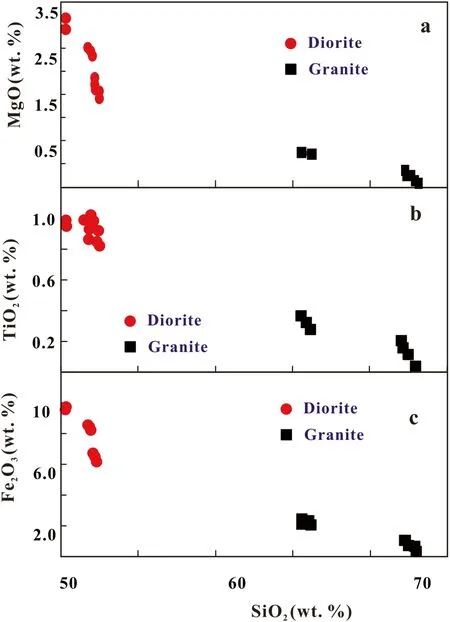
Fig. 11 SiO2 versus MgO, TiO2, and Fe2O3 plots for the rocks studied from the Xinjiang Uygur Autonomous Region, China
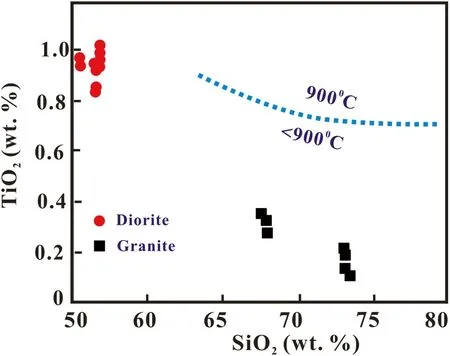
Fig. 12 The SiO2 versus TiO2 temperature diagram for the rocks studied from the Xinjiang Uygur Autonomous Region, China
AcknowledgmentsThe authors would like to thank Dr.Shuqin Yang for his assistance with the XRF analyses,Prof.Liang Qi and Xiaobiao Li for their assistance during the ICP-MS analyses,the technician for assistance during the TIMS Sr-Nd-Pb isotopic analyses, and Prof.Xiaoming Liu for his assistance with the LA-ICP-MS U-Pb dating,upon which data this paper was written.This study was supported by the National Natural Science Foundation of China (Grant No.:41573022).
杂志排行
Acta Geochimica的其它文章
- Late Ordovician mass extinction caused by global warming or cooling?
- In-situ LA-ICP-MS trace element and oxygen isotope signatures of magnetite from the Yamansu deposit, NW China, and their significance
- Geochemical constraints on the origin of Early Cretaceous alkaline intrusions and its tectonic implication, Sulu Orogenic Belt, Eastern North China Craton
- Hydrogeochemical characteristics of groundwater and quality assessment for the purposes of drinking and irrigation in Bougaa area, Northeastern Algeria
- Organic geochemical characteristics of Eocene crude oils from Zhanhua Depression, Bohai Bay Basin, China
- Geochronology and geochemistry of magmatic rocks in the Dongzi-Changhanboluo Pb-Zn ore district in Chifeng,Inner Mongolia, and their relationship with metallogenesis
